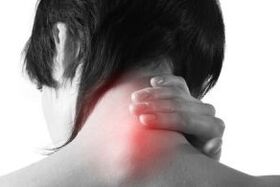onosteochondrosis of the symptoms and cervical spine treatmentThey will be different depending on the type of deformation in the cervical vertebrae obtained in relation to a long physical, inflammatory or mental effect on them.

The disease is often chronic, manifested by many clinical symptoms caused by squeezing the nerve roots and blood vessels coming out of the vertebrae. Their compression is due to the coating or deformation of the intervertebral discs (reducing their height, loss of elasticity, deformation of the fibrous ring or its rupture). Cervical osteochondrosis is a common disease that occurs at any age after 20 years.
The reason for the pathology is in devastating changes in the back. First of all, changes occur in the intervertebral discs: elasticity, their strength and height, their fibrous ring is deformed, extensions (the initial phase of the intervertebral hernia), and hernia appears. All of these changes provoke bone growth in the beads (osteophytes), lead to displacement, and later - to loss of mobility of the cervical vertebrae. Since the spine is a flexible "case" of the spinal cord, the devastating changes in the intervertebral discs and the loss of flexibility of vertebral vertebral vertebrae are harmful to the nerve and vascular structures of the spinal cord. They undergo squeezing, displacement, which disrupts cerebral circulation and intrigue not only of the cervical and shoulder area, but also the internal organs, the lower extremities.
The older the patient, the more intervertebral drives were changed under the influence of age -related muscle weakening, long loads on the back, damage, slowing physical activity, formation of improper behavior, stressful situations and increased neck tension, shoulder band, inflammatory diseases, etc.

Due to its anatomical structure, the cervical spine is more prone to the pathology, as its vertebrae is more mobile and highly placed in relation to one another. Moreover, cervical beads have poor muscle protection. Most often, degenerative changes develop on the intervertebral discs of the most mobile vertebrae 5. 6, 7 of the cervix.
What are the symptoms of cervical osteochondrosis
Diversity and mismatch of symptoms
Osteochondrosis of the symptoms and treatment of the cervical backShould be considered comprehensive and in relation to the type and severity of degeneration of the intervertebral discs. Signs of cervical osteochondrosis are varied and contradictory, as they depend on the localization and strength of manifestation of the deformation process of intervertebral discs, the compression or squeezing of the blood roots and blood vessels, as well as the location of the muscles and organs.
Therefore, often patient complaints are not referred to a neurologist, but other specialists: a cardiologist, therapist, otolaryngologist, an opto -ometwist, a rheumatologist, etc. For example, complaints of dizziness, pain in the shoulder joint or noise in his ears, darkening in the eyes, patients do not accompany the pathology in the neck. At the same time, a neuropathologist can make a diagnosis of cervical osteochondrosis based on the results of an MRI brain and back, brain ultrasound, ECG, etc.
Three sets of signs of damaged nervous system function
Experienced specialists know about thirty different options a combination of symptoms of cervical osteochondrosis. It will not be possible to describe all signs of manifestations of this ordinary disease, so let's stopthree complexThe main symptoms that characterize a certain damaged function of the central nervous system.
The first complex of the underlying symptoms applies to the damaged functions of the peripheral section of the nervous system. This department is represented by the nerves and other elements that are leaving the brain and spinal cord, and is divided into somatic and autonomous systems.
In short, the first complex of the symptoms of cervical osteochondrosis is presented in the form of different localization of pain. This is not to say that the signs are only painful, often pain is combined with other damaged body functions. But mostly - these are persistent or periodically pain in the neck, the appearance of which the patient is associated with hypothermia, prolonged stress or in an unpleasant position, lifting weights, a sharp twist of the head.
Pain is hurting, shooting or similar to a shock. Their localization depends on the tension of the certain muscles associated with the specific nerve roots, which are squeezed by the vertebrae. Therefore, the pain can spread to the neck, nap, shoulder, one or both hands, radiate to the chest - in the area of the heart, liver. In addition, there are complaints about crunch or cracking in the vertebrae of the cervical region when the head moves, as well as the rigidity of the rotating head movements.
At the acute onset of the disease, the pain and spasms of the neck muscles force the patient to be in a position with his prone head and leave. Burning pains can occur between shoulder blades if vegetative cervical formations are compressed and their blood supply is disturbed. Such pains usually increase with physical and emotional stress.
Often there is swelling, pallor and colds of hands, their numbness, rapid heartbeat, heart pain, narrowing or enlargement of students, etc. Due to the intrigue of the shoulders and the spatular region, symptoms of a dystrophic change in the shoulder joint may occur. Patients complain of pain, inability to raise and take the hand on the side, stiffness of the shoulder joint.
The second complex of symptoms of cervical osteochondrosis occurs due to damaged spinal cord function, and is manifested by engine disorders.
Disordishes of spinal cord function disorders occur due to its compression as a result of the loss of a pulposal core from the disk or damage with discs and solid growth (osteophytes). Depending on the mechanism of exposure to the spinal cord, the following complex of motor disorders is observed: occipital and cervical muscle stiffness, weakness of the arms and legs, with an increased tone of the leg muscles and decreased tone and weight loss; loss of temperature and pain sensitivity; Strong leg fatigue, impaired coordination.
The third set of symptoms characterizes blood supply disorders in the brain vessels and the pathology of the cranial nerves that occur due to deformities in the cervical vertebrae. Symptoms of vascular pathology manifest.
Characteristic symptoms of vascular disorders:
The symptoms of cervical osteochondrosis are not unclear, and should be considered in complexes and depending on the pathological processes in the spine.
Only a qualified specialist can deal with the clinical manifestations of this disease, make the correct diagnosis and prescribe the correct treatment of the causes of the disorder detected.
How to treat this disease
Osteochondrosis of the symptoms of the cervical spine depends on the patient's condition, the severity of the disease, the nature of the cervical vertebra damage.
In the acute period, hospitalization and drug treatment may be required. Usually use analgesics, Novokain muscle blockade, muscle relaxants that relieve muscle spasm; Chondroproprotectors for the food of the cartilage fabric; Painted medicines that soothe the nervous system, B vitamins, increasing neuromuscular conductivity. The treatment of cervical spine osteochondrosis is always long, and should be complex.
During periods of forgiveness, when acute symptoms are missing, physiotherapy methods (electrophoresis, ultrasound, etc. ) are widely used, physical therapeutic education, massage, as well as non -traditional procedures, for example, acupuncture, are necessarily prescribed.

Many conservative methods of treatment of osteochondrosis are known, which can stop the progression of the disease. However, each patient needs an individual course of treatment taking into account the stage of the disease, the characteristics of the body, gender and age. The purpose of treatment of cervical osteochondrosis is:
The intended complex treatment can prevent the emergence of prottrus and intervertebral hernias.
In order for the symptoms and osteochondrosis of the treatment and treatment is not initiated, and the severe complications of the disease must begin to begin timely treatment.

























